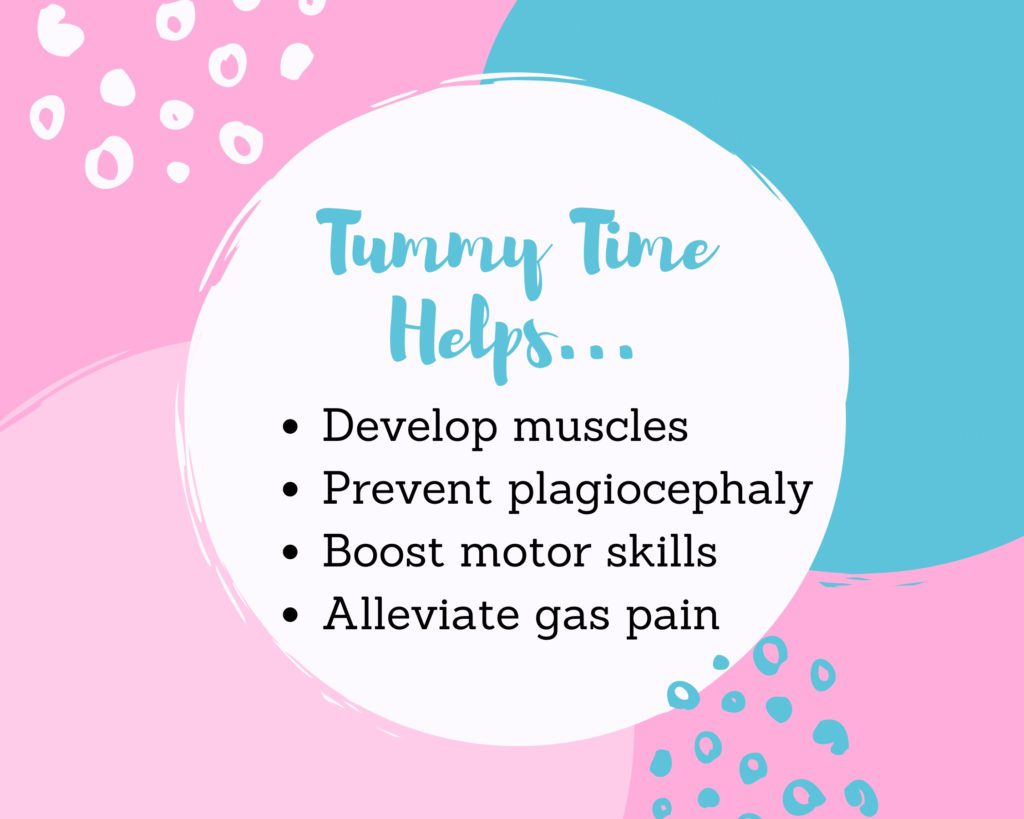
Making Your Newborn’s Tummy Time Fun, Safe, and Effective
Considering how much time your newborn spends sleeping, it’s hard to believe that she could do any exercise. However, a little workout for your baby is important for so many reasons!
Your baby’s first exercise should be tummy time, which is exactly what it sounds like. You place your baby on her tummy rather than her back, where she spends most of her time. Tummy time helps your baby develop muscles in her arms, shoulders, upper back, and neck. It also helps to prevent the back of her head from flattening out, a condition known as plagiocephaly. Additionally, tummy time helps boost motor skills and alleviate gas pain.
How Much Tummy Time Should Baby Get?
Tummy time expert Dr. Michelle Emmanuel recommends you introduce tummy time to your newborn baby right from the very start. But how long should your baby practice tummy time? Below are Dr. Emmanuel’s recommendations:
- Newborn-2 months old – spend a minimum of 30 minutes per day during awake periods
- 2-4 months old – spend a minimum of 45-90 minutes per day during awake periods
- 4-6 months old – spend a minimum of 1-2 hours per day during awake periods
- 6-8 months old – the majority of waking hours will be spent in tummy time or sitting/learning to sit.

Tummy Time Strategies for Your Newborn
The key to a great tummy time strategy for your baby is to start for shorter periods several times a day. Gradually increase the time until your baby has more developed muscles and can move around better on her own. Experts also recommend doing tummy time after a nap or a diaper change, introducing it as a part of playtime. And of course, always do tummy time when your baby is awake. The American Academy of Pediatrics warns you to never put your sleeping baby on her tummy.
It’s typical for babies, however, to dislike tummy time, especially at first. Those newborn muscles that aren’t developed yet limit your baby’s movement and your new baby could find it frustrating.
“The soft tissue structures require mobilization in tummy time and this requires flexibility and optimization of tongue, throat and shoulder girdle musculature, areas which often are tight and restricted for these babies. Babies, especially in the first twelve weeks of life, considered the fourth trimester, need your help regulating and calming themselves. Babies are experiencing lots of sensory input from their body, the environment and from caregiving experiences, and this includes tummy time,” says Dr. Emmanuel.
Thankfully there are different ways of doing tummy time. There are even some tools you can use to increase the chances your baby will enjoy spending time on her belly.
Mom Beka Pinkston Janish said that being on the floor was a big problem for her little one. “We started pretty early, during the first couple of weeks, but both my kids HATED tummy time on the floor. We just did it with them laying face down on me or my husband,” Janish said.
Jenna Lynn McCauley uses the television and a mirror to keep her baby occupied during tummy time. “I started tummy time in the hospital. I just had her on my chest doing it, but she came out holding her head up pretty good. She’s three months now, and she does it on a mat. I turn the TV on for her, and she watches that or looks at her reflection in the mirror I put beside the TV for her,” said McCauley.

Tummy Time Tools for Your Baby
While the TV works for some, there are also other options, like cards and toys specifically made for use during tummy time.
Lindsey Horan got her baby boy tummy time cards. “We started immediately, but for very short time spans at first, gradually increasing the time every few days,” Horan said. “My kiddo had a very strong neck from the beginning and was able to roll himself over from tummy to back very early so he wouldn’t stay on his tummy long. We really liked our set of tummy time cards and mirror. Putting something in front of him to look at was key in keeping him on his tummy for a little longer.”
Along with toys, there are tummy time apps for smartphones and tablets. These can keep your baby entertained during her little workouts and track her progress.
The Tummy Time Abstract app uses noises, like bells and beeps and music, along with high contrast black and white images to get and hold your baby’s attention.
My Baby Gym app allows you to track your baby’s progress and even share it with family and friends. There are several other tummy time tracker tools in the Apple app store as well.
It’s important that whatever method works for your newborn baby, tummy time should never be unsupervised. Always keep an eye on your baby during tummy time – and have fun!
New Mom from Houston, Texas, Amy Leroy, says she finds the early morning the best time for putting her new baby down for tummy time. Encouraging tummy time before baby gets tired late in the day means she will have more energy for longer periods of time. Amy also waits at least 30 minutes after feedings to make sure baby’s stomach has settled.
Thank you for sharing your tips Amy!


